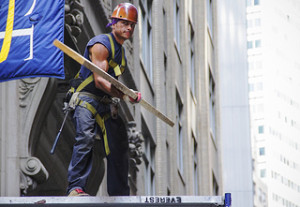Six workers died from falls last year in BC – as safety advocates look for solutions to this serious problem that affects many industries, especially construction. WorkSafeBC ran a six-week inspection blitz that led to 1,356 orders and 23 penalties for employers.

Photo credit: Michael Tapp on Flickr. Note: this worker is not known to be involved in any incidents.
I was quite surprised to hear they found eight workers wearing fall protection gear but not attached to an anchor or lifeline.
That’s so pointless – like people who ride bikes with helmets dangling from their handlebars. The fact that workers are in this situation shows we have to keep the topic of fall protection in the air. Why weren’t they attached properly? Where were their supervisors? So many questions to answer…
Fall protection is on the radar in other jurisdictions too. I’ve looked at their efforts across North America, in the UK, and Australia. Their stats on fall injuries are most likely similar to ours in BC, where:
* 17 percent of all WorkSafeBC claims are due to falls
* 25 percent of serious injuries are due to falls
* 29 percent of all claims costs are due to falls
Advising on fall protection in BC
“Having a fall prevention strategy and plan in place is vitally important to ensuring worker safety,” says Mike McKenna, executive director of the BC Construction Safety Association (BCCSA).
The BCCSA is a not-for-profit association run by industry. Their safety advisors and staff provide advice, services, and safety certification to BC’s construction employers. They are a WorkSafeBC Certifying Partner that works with the province’s construction employers who employ more than 180,000 workers altogether.
I asked Mike what BCCSA is telling members about the importance of fall protection. He said a fall protection plan – with a rescue component – is critical, along with other lines of defence like guards and guardrails.
“A worker who survives a fall by using appropriate fall arrest systems doesn’t mean the company has properly ensured their worker’s safety,” Mike said, describing how workers can still be injured even though they don’t hit the ground.
“The risk of a worker dying because of pressure on their vitals while waiting to be rescued is also a danger and why having a fall rescue plan in place is critical.”
BC’s fall protection requirements
Please see Part 11 of the OHS Regulation and WorkSafeBC’s Fall Protection Workshop.
For now, here’s the requirement:
An employer must ensure that a fall protection system is used when work is being done at a place
(a) from which a fall of 3 m (10 ft.) or more may occur, or
(b) where a fall from a height of less than 3 m involves a risk of injury greater than the risk of injury from the impact on a flat surface.
“Prevention is key”
“The best safety precaution is always to eliminate or substitute the hazard,” Mike says. “Prevention is key. Companies should put greater emphasis on preventing falls by using engineering controls, administrative controls, or personal protective equipment. It might be necessary to use a combination of all types of controls.”
“Companies need to remember that each situation will be unique, with different circumstances that require a specialized plan. If a company requires help in developing a plan they can always call us. We have Regional Safety Advisers with many years’ experience in the industry who are here to help,” he says.
Thanks to Mike for sharing this info – and please do contact BCCSA if you would like to speak with a safety advisor about your specific situation in BC.


